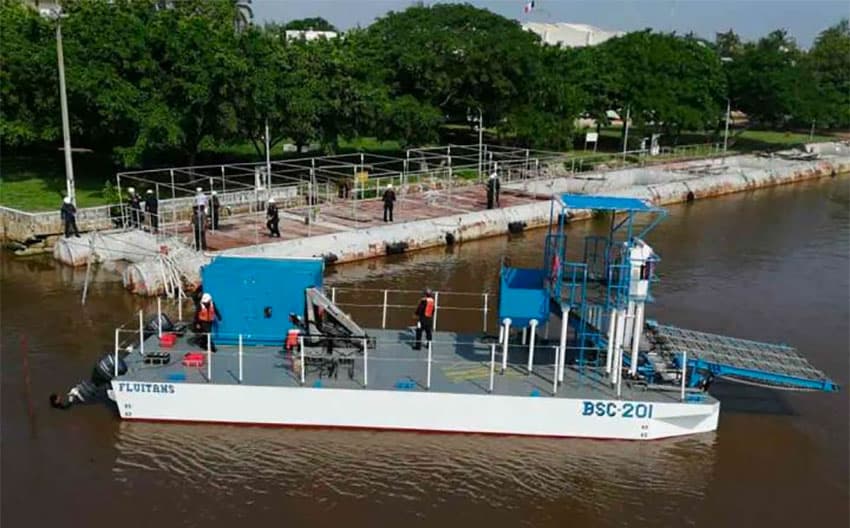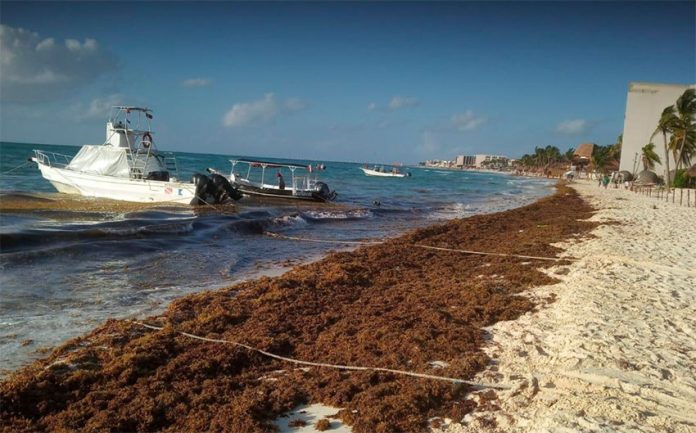The federal government on Wednesday denied the presence of sargassum on Quintana Roo beaches after media reports said Tuesday that brigades of workers had begun removing the smelly, unsightly seaweed from the state’s Caribbean coastline.
Claiming that false information had been published by the newspaper Reforma, President López Obrador asserted that the state’s beaches are clear of sargassum, which washes up on Mexico’s Caribbean coast every year, usually between March and September.
“Fortunately there is no sargassum, the beaches are clean; the Caribbean is a paradise with its turquoise blue water. We’re now managing to reduce contagion [of the coronavirus], there are now green light states [on the coronavirus risk map] and tourist activity will recover soon,” he told reporters at his morning news conference with his usual dose of optimism.
Deputy Navy Minister Eduardo Redondo Arámburo confirmed the president’s statement, claiming that seagrass had been mistaken for the macroalgae.
“There is no sargassum currently [on beaches]; there are small patches very far [out at sea],” the admiral said, explaining that the navy has been making flyovers of the Caribbean Sea since the start of the year.

“… I can assure you that the Caribbean Sea beaches are clean and ready for tourists to go to them to swim and enjoy our Mexican Caribbean,” Redondo said. “The Ministry of the Navy will continue working hand in hand with other institutions to keep the beaches clean.”
Redondo said the navy has nine shallow-water sargassum removal vessels and they are already at sea. He also said that a deep-water vessel will be deployed in the coming days and that sargassum barriers are being installed in Tulum, one of several Quintana Roo destinations expected to see an influx of visitors over the Easter vacation period.
But numerous hoteliers and tourists today rejected the government’s claims that there was no sargassum, posting photos and videos to social media that showed masses of the seaweed washed up on the coastline. Akumal Sur, Mahahual and Playa del Carmen were among the locations affected.
In addition, the Cancún sargassum monitoring network published a new map on Wednesday that showed that there are moderate amounts of the weed at 26 beaches and abundant quantities at three beaches on the northeastern coast of Cozumel, a small island off the coast of Playa del Carmen. An additional 36 Quintana Roo beaches have very low quantities of sargassum, while only 15 are completely untainted by the brown seaweed.
Various experts also confirmed that there is indeed sargassum in the state. Alejandro Bravo, an oceanographer and member of the Quintana Roo government’s sargassum committee, told the newspaper Milenio that there has been a “significant presence” of the seaweed on beaches for the past month. He said sargassum actually began arriving in January, surprising members of the committee because it doesn’t normally reach Quintana Roo until later in the year.
“It hasn’t arrived in overwhelming quantities but its presence is significant,” Bravo said.
Brigitta Ine van Tussenbroek, a scientist at the National Autonomous University’s Institute of Marine Sciences and Limnology and another committee member, said that sargassum has arrived in recent weeks, although not in “catastrophic quantities.”
Greater quantities could arrive later in the season depending on the behavior of ocean currents, she said.
Joel González Chiñas, an oceanographer and biologist who has been researching the sargassum problem since 2015, told Reforma that it appeared that the government has “other information” – a phrase frequently used by López Obrador when confronted with information he doesn’t agree with – because “there are moderate and manageable arrivals” of the weed on Quintana Roo beaches.
“There are photographs and maps [of the sargassum], it’s not something we’re hiding. There are people who walk on the beach and send photos. In hotels there are daily cleaning brigades …” he said.
